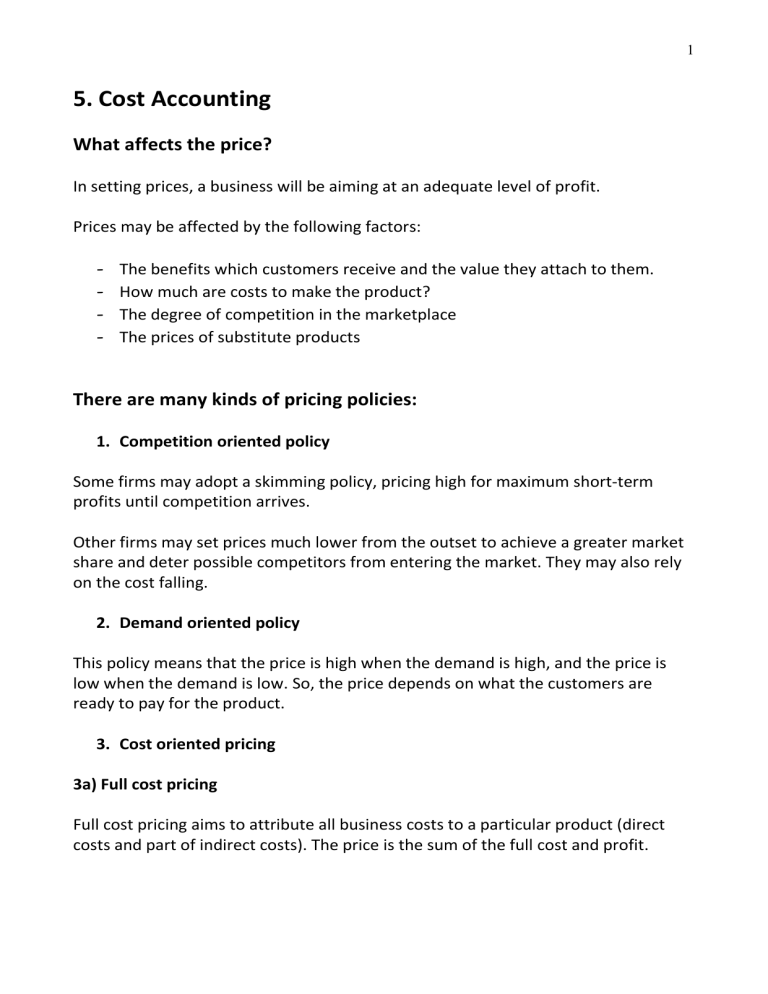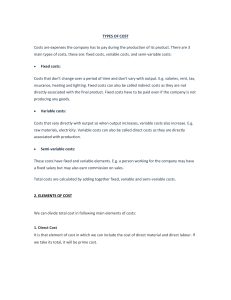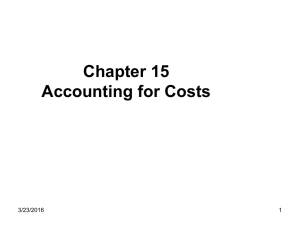
1 5. Cost Accounting What affects the price? In setting prices, a business will be aiming at an adequate level of profit. Prices may be affected by the following factors: - The benefits which customers receive and the value they attach to them. How much are costs to make the product? The degree of competition in the marketplace The prices of substitute products There are many kinds of pricing policies: 1. Competition oriented policy Some firms may adopt a skimming policy, pricing high for maximum short-term profits until competition arrives. Other firms may set prices much lower from the outset to achieve a greater market share and deter possible competitors from entering the market. They may also rely on the cost falling. 2. Demand oriented policy This policy means that the price is high when the demand is high, and the price is low when the demand is low. So, the price depends on what the customers are ready to pay for the product. 3. Cost oriented pricing 3a) Full cost pricing Full cost pricing aims to attribute all business costs to a particular product (direct costs and part of indirect costs). The price is the sum of the full cost and profit. 2 full cost + profit = price without VAT + VAT = price including VAT Unlike direct costs, however, indirect costs (overheads), by definition, cannot be directly identified with particular products. Hence, there is first a need for apportion indirect costs to cost centers; and then for attributing the total costs of each of the cost centers to the various products which pass through them. A cost center is a part of a business in respect to which costs can be identified and aggregated. It may be a whole factory, a part of a factory, department, or even a single machine. Different cost centers may be appropriated for different levels of management decision. Example 1 ABC Ltd makes trousers. There are three cost centers: stock, production and management and marketing. D Direct material costs 200 000 Direct labour costs 180 000 Indirect costs: 18 000 Stock Total costs 578 000 Products 60 000 Production 120 000 Profit 50 000 Management and marketing 3 Overhead rates (overhead cost increments): Stock 100* indirect stocking costs direct material costs 100 * 18 000 = 9 % 200 000 Production 100* indirect production costs direct labour costs 100 * 60 000 = 33,33 % 180 000 Management and marketing 100* indirect management and marketing costs production value 100 * 120 000 = 26,20 % 458 000 Profit 100* profit full cost (=total costs) 100 * 50 000 = 8,65 % 578 000 Price of trousers: Direct raw material costs Overheads of stock 9% * 77 Direct labour costs Overheads of production 33,33% * 30 Production value Overheads of management and marketing 26,2 % * 123,93 Full cost Profit 8,65% * 156,40 Price without VAT VAT 24% * 169,93 Price including VAT 77 6,93 30 10 123,93 32,47 156,40 13,53 169,93 40,79 210,75 4 Exercises: 1. There are three cost centers in Roberts company: stock, production and management and marketing. The costs are as follows: D Direct material costs 180 000 Direct labour costs 70 000 Indirect costs: 16 200 Total costs 387 580 Stock Products 59 500 Production 61 880 Management and marketing a) Define the overhead rates. b) How much is the price including VAT of the X-product, when the direct material costs are 920,- and direct labour costs 370,-? 5 2. DC Ltd makes many kind of machines. There are three cost centers: stock, production and management and marketing. D Direct material costs 320 000 Direct labour costs 150 000 Indirect costs: 27 900 Total costs 885 000 Stock Products 241 100 Production 146 000 Management and marketing a) Define the overhead rates. b) How much is the price including VAT of the Y-machine, when the direct material costs are 1 920,- and direct labour costs 2 370,-? 6 3. DEF Ltd produces various antennas for radios and televisions. The following costs have been budgeted for the next year: Direct material costs Direct labour costs Indirect stocking (storage costs) Indirect production costs Indirect management and marketing costs Budgeted profit 900 000 800 000 200 000 150 000 300 000 130 000 a) How much is the price including VAT of the TV-antenna, when the direct material costs are 80,- and direct labour costs 70,-? b) How much is the price including VAT of the TV-antenna, when the direct material costs are 170,- and direct labour costs 140,-? 4. XYZ Ltd produces various parts for cars. The following costs have been budgeted for the next year: Direct material costs Direct labour costs Indirect stocking (storage costs) Indirect production costs Indirect management and marketing costs Budgeted profit 3 220 000 900 000 700 000 740 000 1 060 000 90 000 a)How much is the price including VAT of the X-product, when the direct material costs are 120,- and direct labour costs 40,-? b)How much is the price including VAT of the X-product, when the direct material costs are 30,- and direct labour costs 20,-? 7 Example 2 In retail shops costs of goods are direct costs. The other costs are indirect. Overhead rate= 100 * (indirect costs + profit) direct costs Ladies Fashion’s cost budget for the following year is as follows: - goods - salaries - rent - office - advertising - depreciation - interest - other overheads 132 000 65 000 15 000 5 000 7 100 4 100 3 900 1 900 The budgeted profit for the following year is 35 000 euros. Overhead rate = 100 *(102 000 + 35 000) = 103,79% 132 000 The price of the jacket: Direct costs Indirect costs + profit 103,79%*200 Price without VAT VAT 24 % * 407,58 Price including VAT 200 207,58 407,58 97,82 505,40 8 Exercises: 5.Lasse has an ice-cream stall. The budgeted costs for the following year are as follows: - material (ice-cream, chocolate…) - rent - salaries - depreciation - interest - other overheads a) b) c) 45 000 23 320 79 300 5 400 6 100 2 900 How much is the overhead rate (without profit)? How much is the overhead rate, if the expected profit for the following year is 10 000 euros? How much should the price of an ice-cream serving be, if the direct costs are 1,20 euros. Use the overhead rate of b)? 6. Delicatessen shop sells salads and ice-creams. The costs for the following year are as follows: - material - salaries - social costs - depreciation - rent - interest - light, heat - maintenance - other overheads a) b) c) 65 900 63 600 26 600 7 100 7 900 4 200 2 800 2 400 1 900 How much is the overhead rate (without profit)? How much is the overhead rate, if the expected profit for the following year is 9 500 euros? How much should the price of a salad serving be, if the direct costs are 1,80 euros. (Use the overhead rate of b)? 9 7. Anna has a shop. She sells underwear. She has estimated the costs for the following year: - goods - salaries - social costs - rent - advertising - depreciation - interest - other overheads 600 000 190 000 80 000 36 000 20 000 12 000 15 000 10 000 The profit should be 160 000 euros next year. a) b) 8. How much is the overhead rate? How much should the price of stockings be, if the direct costs are 10 euros? Sport shop’s budget for the following year is as follows: Sales - Goods = Contribution - Rent - Advertising - Depreciation - Interest - Other overheads = Profit a) b) 300 000 213 000 87 000 21 000 3 000 3 000 6 000 6 000 48 000 How much is the the overhead rate? How much should the price of a bicycle be, if the direct costs are 280 euros? 10 Example 3 In the service sector part of salaries are often direct costs. Other costs are indirect costs. Overhead rate 1 = 100 * (indirect costs + profit) direct salaries and social costs or Overhead rate 2 = indirect costs + profit total direct working hours In Advertising Company there are 10 workers whose working time can be allocated to the commissions. Their annual salaries and social costs are as follows: Advertising manager Art director Copywriter Assistant Direct costs 3 * 55 000 = 165 000 2 * 50 000 = 100 000 2 * 42 000 = 84 000 3 * 34 000 = 102 000 451 000 The indirect costs per year are 382 000 euros and the expected profit per year 120 000 euros. Overhead rate 1 = 100 * (382 000 + 120 000 = 111,31 % 451 000 Yearly working hours are 1408 hours per worker. Price/ hour: Direct salaries Indirect Price/hour and social costs+profit costs/hour /hour 39,06 43,48 82,54 111,31 %*39,06 35,51 39,53 75,04 Advertising manager Art director 55 000/1408 Copywriter 42 000/1408 29,83 33,20 63,03 Assistant 34 000/1408 24,15 26,88 51,03 50 000/1408 11 Overhead rate 2 = 382 000 + 120 000 = 35,65 euros/hour 14080 Price/hour Advertising manager Art director Direct salaries Indirect Price/hour and social costs+profit costs/hour /hour 39,06 35,65 74,71 35,51 35,65 71,16 Copywriter 29,83 35,65 65,48 Assistant 24,15 35,65 59,80 Costs of an advertisement, witch takes 1 hour advertising manager’s, art director’s, copywriter’s and assistant’s working time: 1. 82,54 + 75,04 + 63,03 + 51,03 = + VAT 24 % * 271,64 Price with VAT 271,64 65,19 336,83 2. 74,71 + 71,16 + 65,48 + 59,80 = + VAT 24 % * 271,15 Price with VAT 271,15 65,08 336,23 Exercises 9. In Auditing Company there are 10 workers whose working time can be allocated to the commissions. Their annual salaries and social costs are as follows: Auditor Accountant Assistant Direct costs 2 * 56 000 = 112 000 5 * 43 000 = 215 000 3 * 24 000 = 72 000 399 000 The indirect costs per year are 189 000 euros and the expected profit per year 20 000 euros. Yearly working time is 1496 hours/worker. 12 a) b) c) How much is the overhead rate 1 ? How much is the overheat rate 2 ? How much should the price (with VAT) of a commission be, if it takes time as follows: Auditor Accountant Assistant 2 hours 8 hours 3 hours


